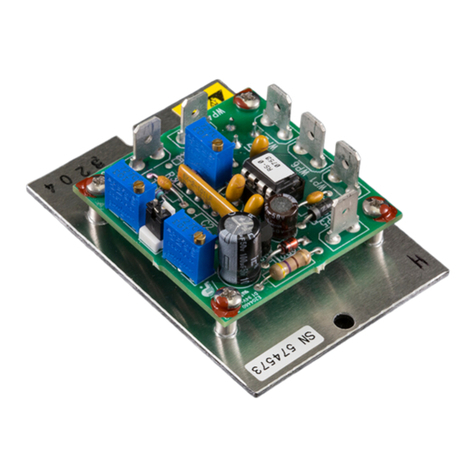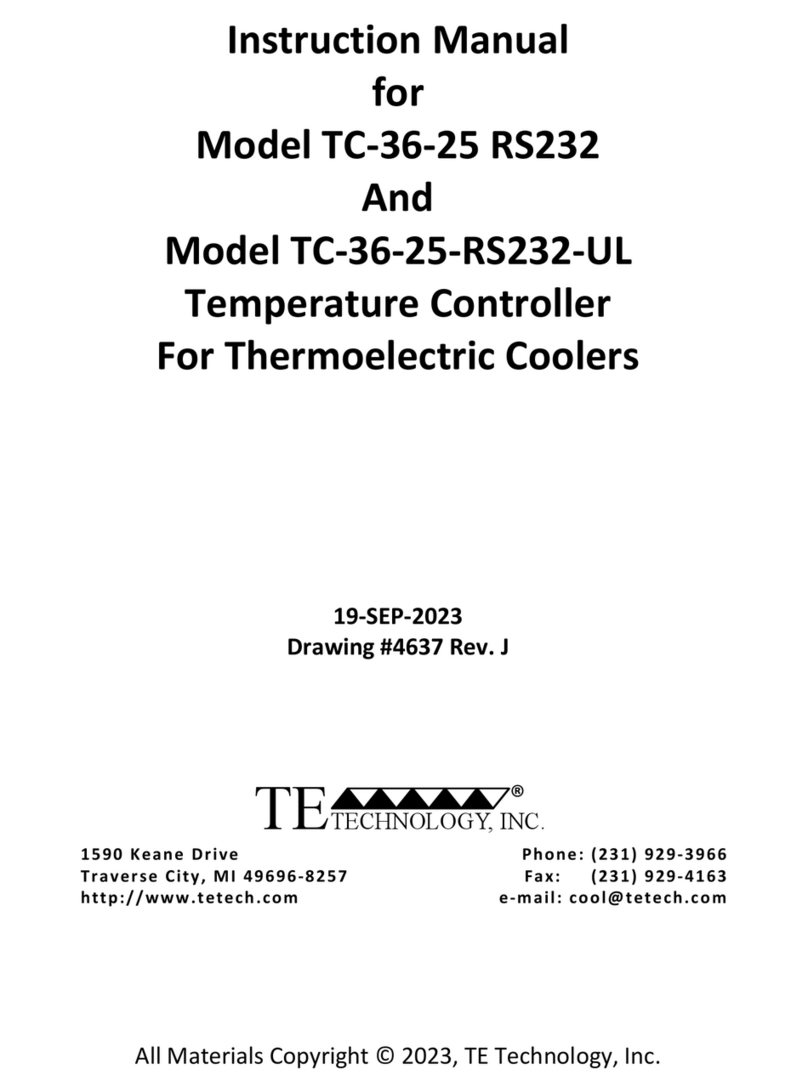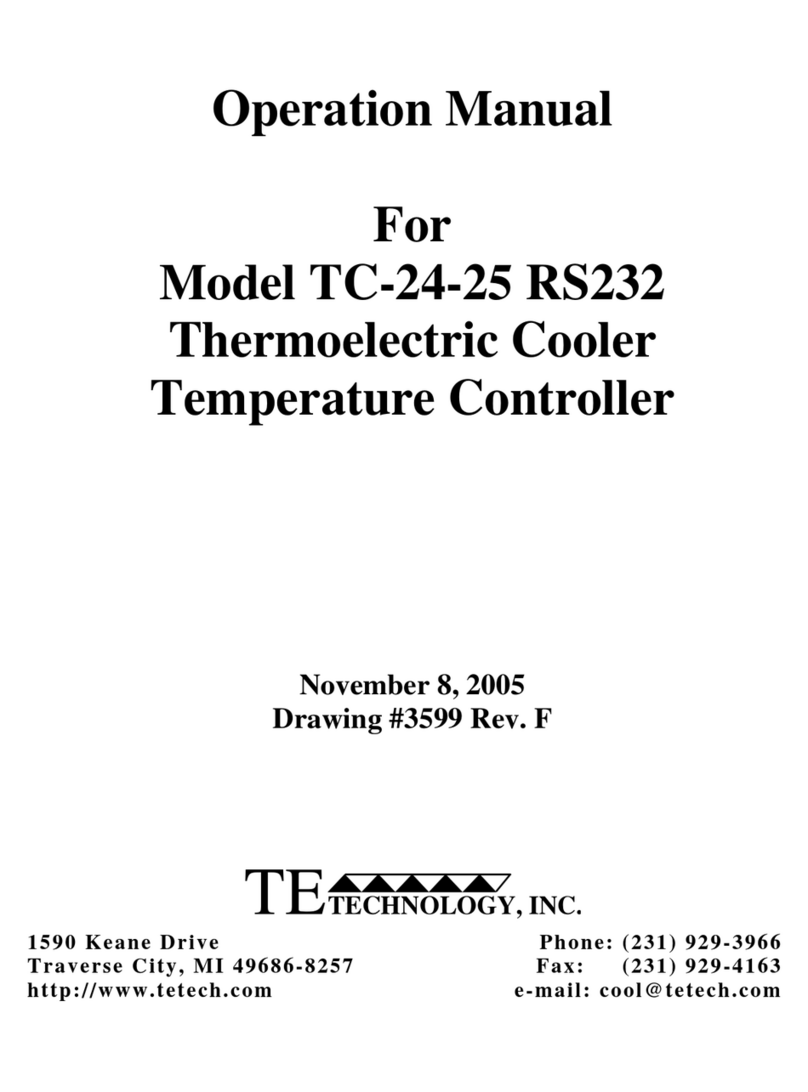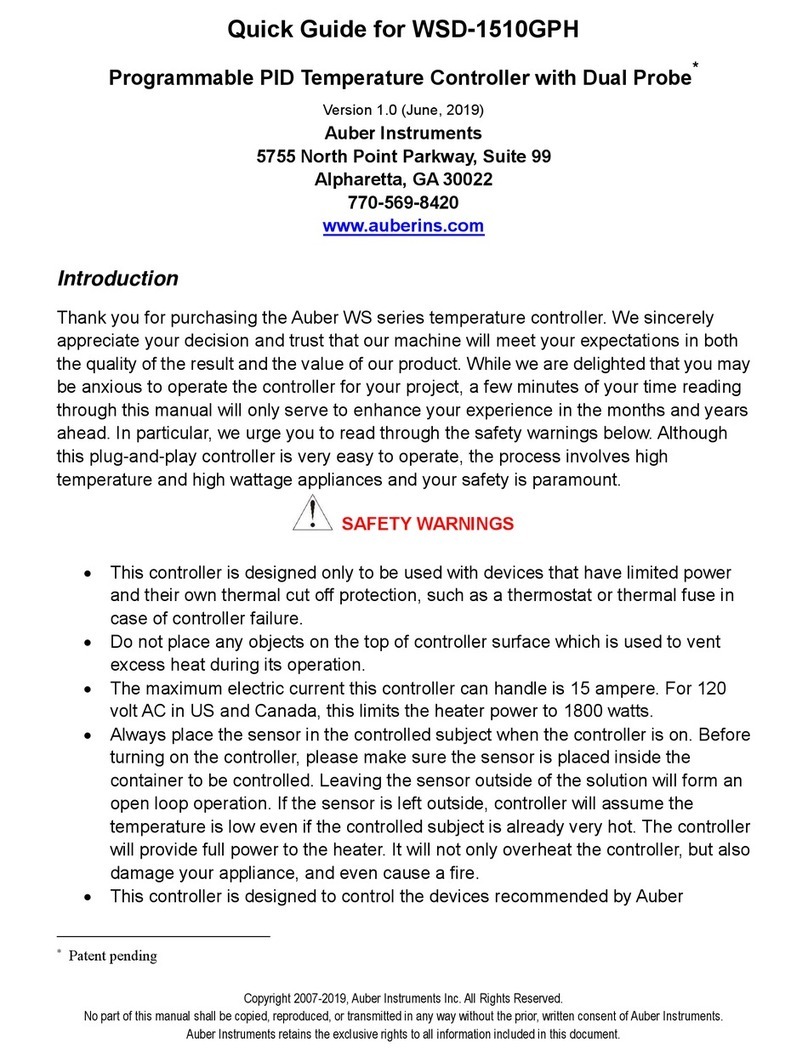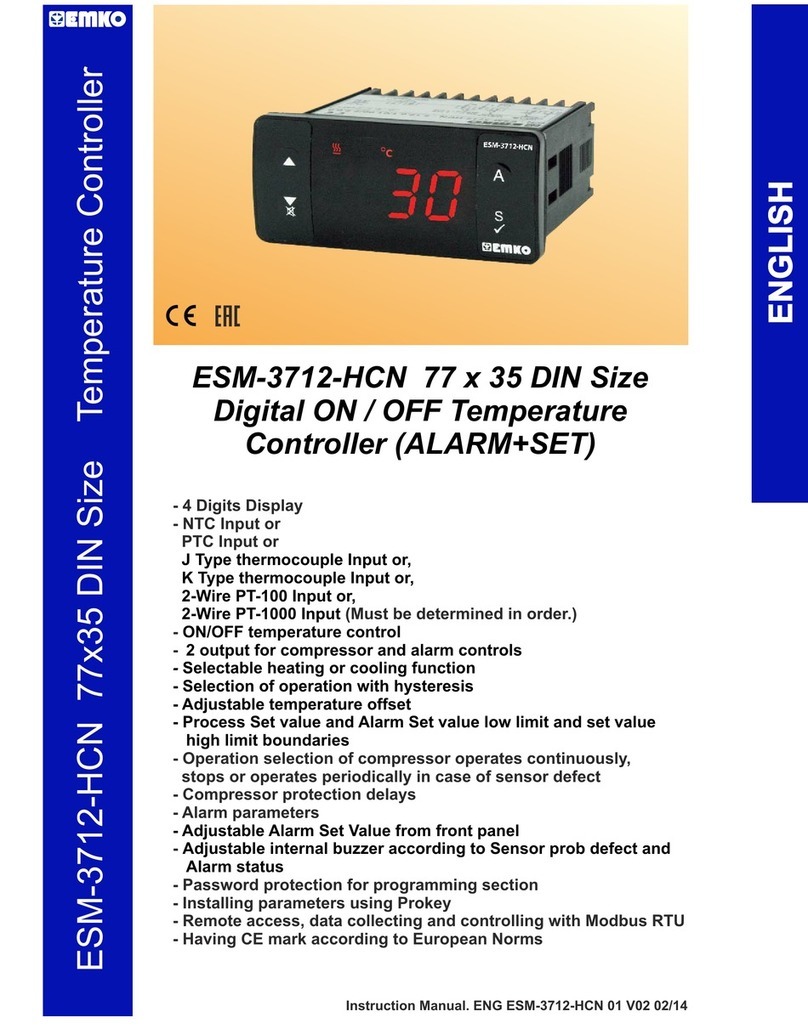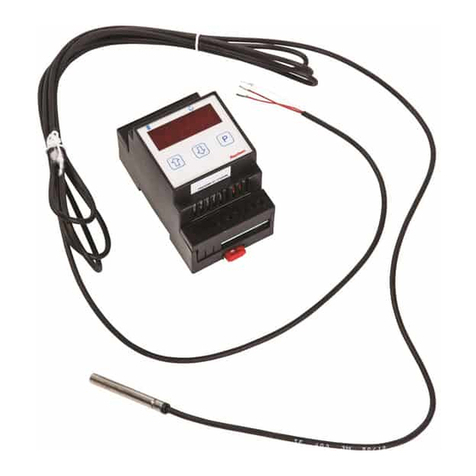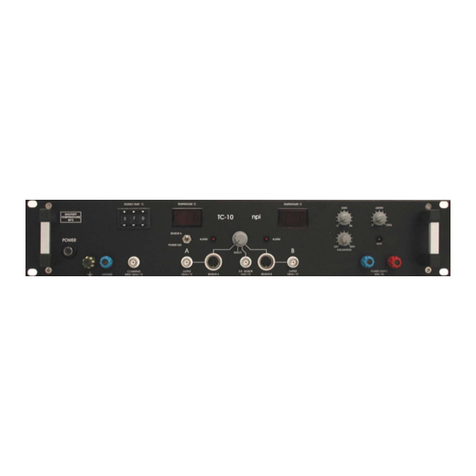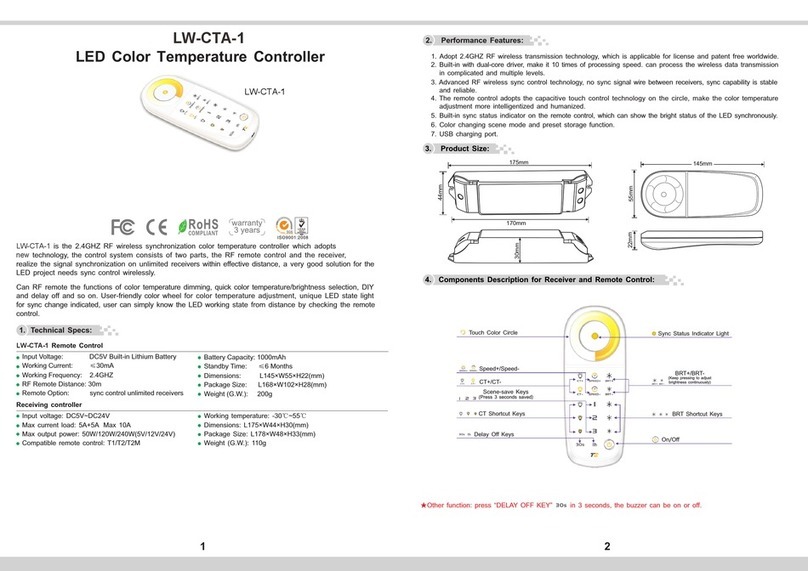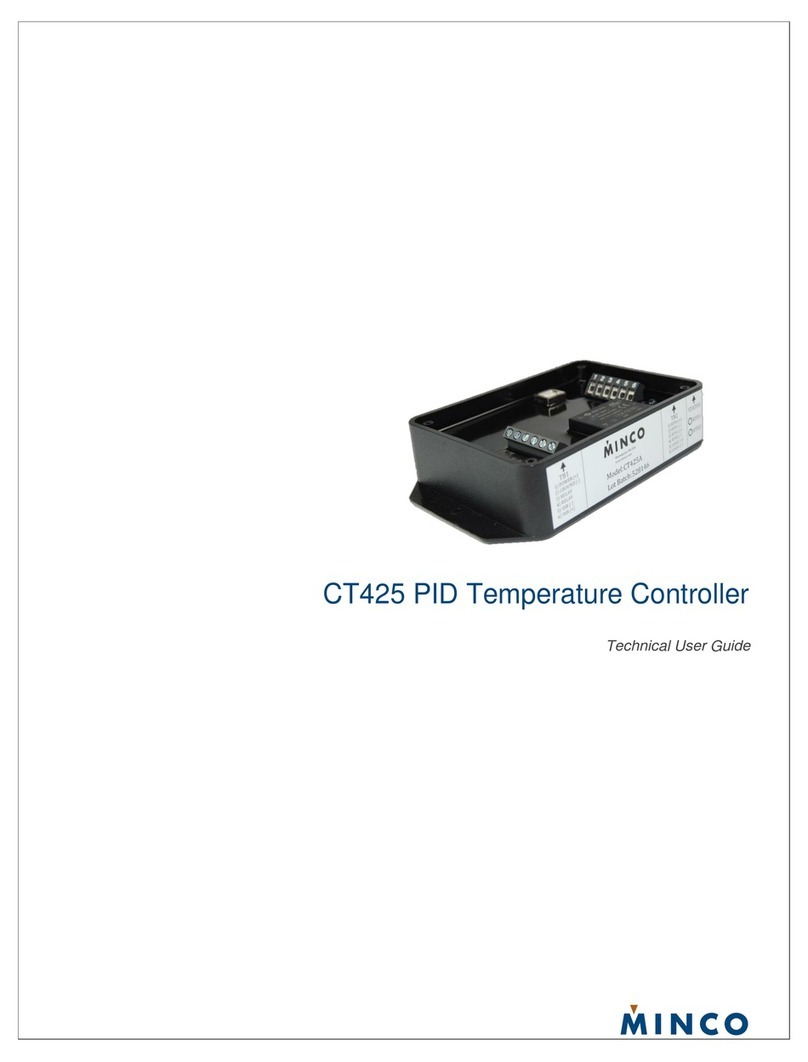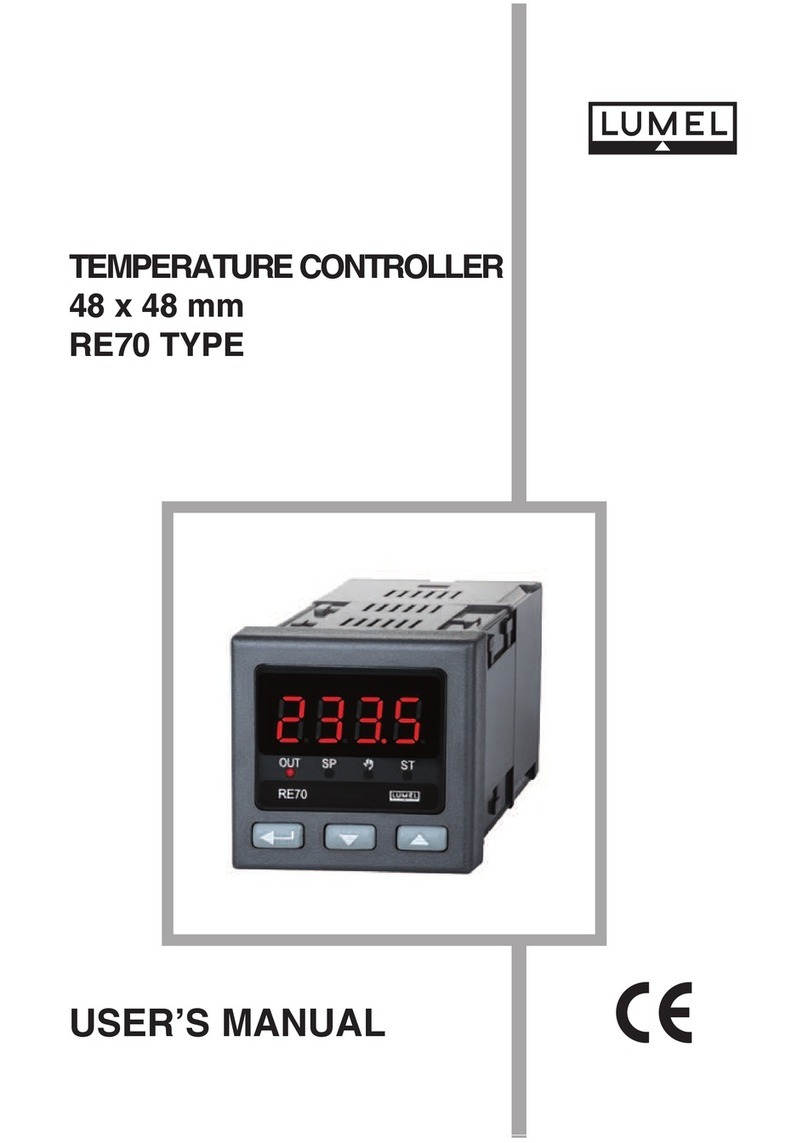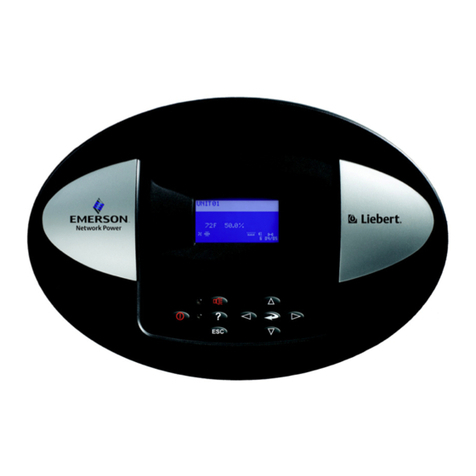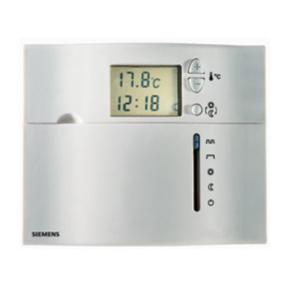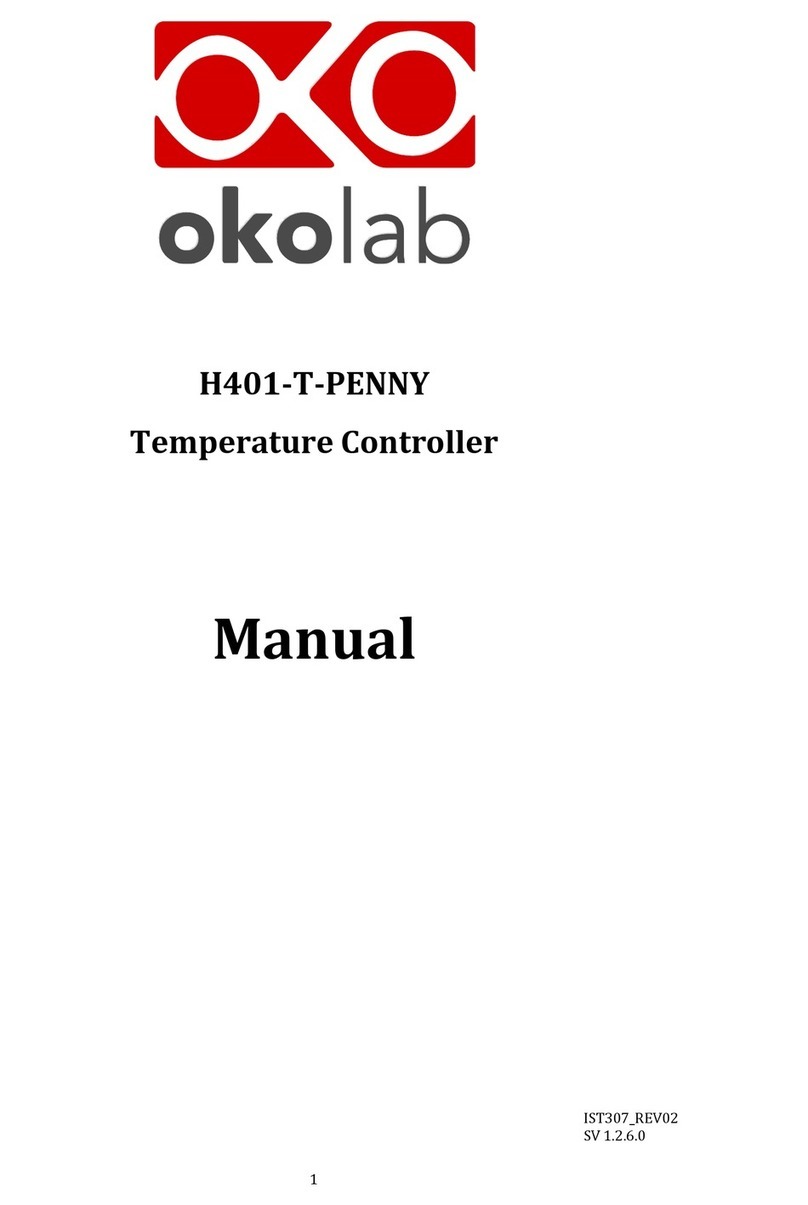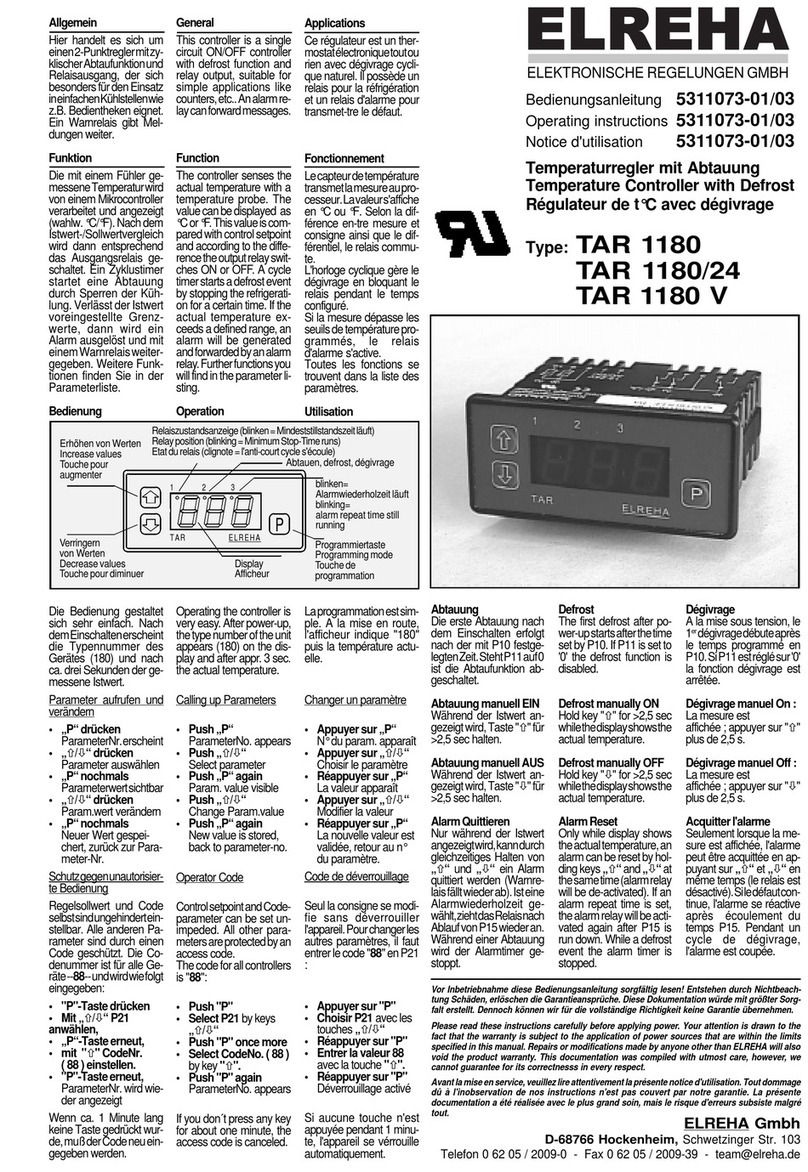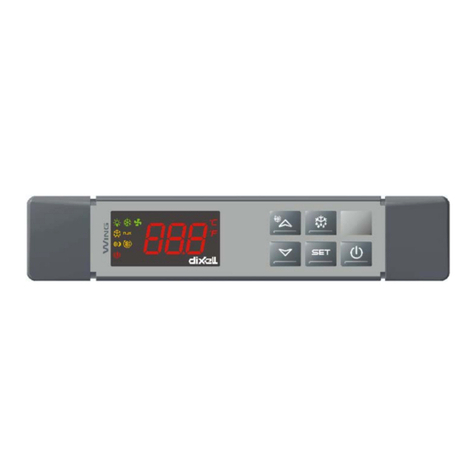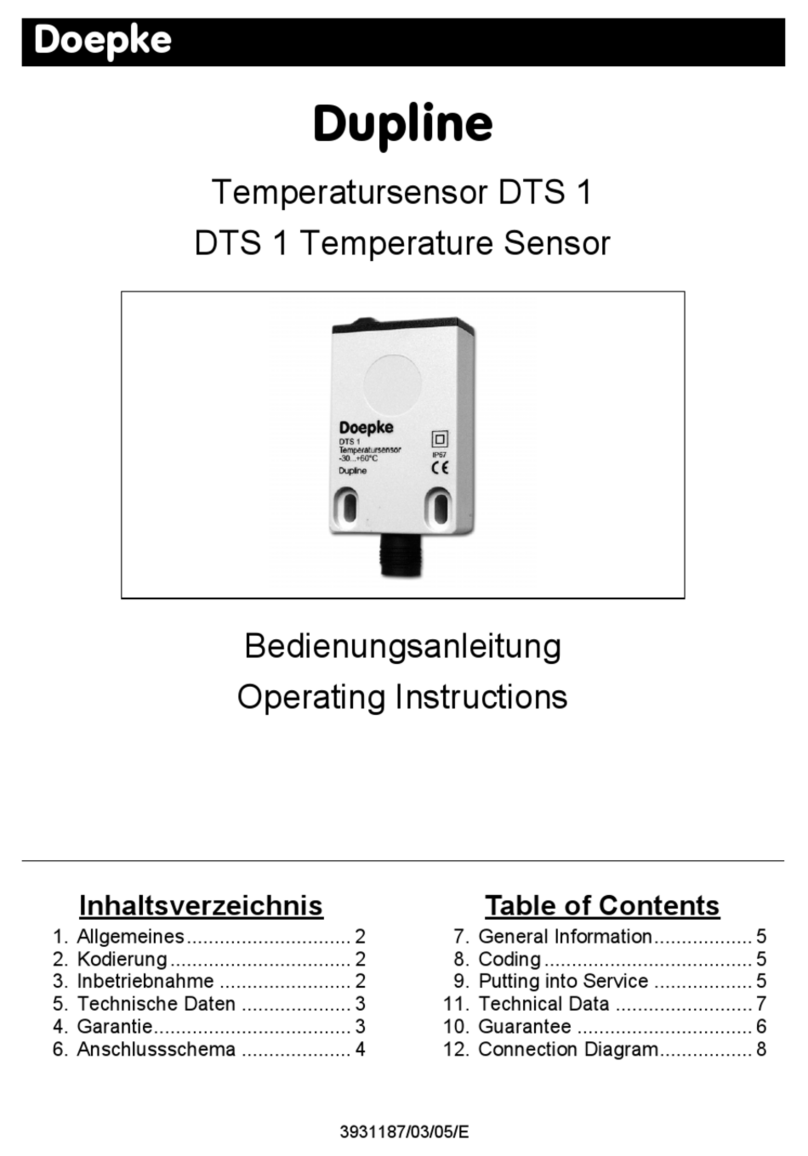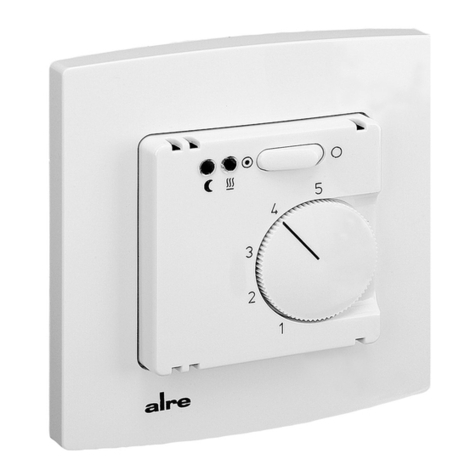TE Technology TC-48-20 User manual

Instruction Manual
for
Model TC-48-20
and
Model TC-48-20 OEM
Thermoelectric Cooler
Temperature Controller
April 7, 2020
Drawing #4746 Rev. F
1590 Keane Drive Phone: (231) 929-3966
Traverse City, MI 49696-8257 Fax: (231) 929-4163
www.tetech.com e-mail: cool@tetech.com
All Materials Copyright ©2020 TE Technology, Inc.

2
General Safety Warnings
This manual is available in English only. It must be read and followed carefully before installation and
operation. All warnings in this Operation Manual apply to both the TC-48-20 and TC-48-20 OEM versions of
the controller. Where “TC-48-20” is referenced, it is used generically and interchangeably for both the TC-
48-20 and the TC-48-20 OEM versions of the controller, except where otherwise specifically noted.
THE LATEST REVISION OF THIS MANUAL IS AVAILABLE AT www.tetech.com. Verify that you are
using the latest revision available.
Do not use in an explosive or potentially explosive environment.
The TC-48-20 should not be used as a toy, or serious injury could result. The TC-48-20 should only
be used for its intended purpose of providing temperature control of TE Technology’s
thermoelectric devices only. The controller is intended for light industrial, laboratory, or similar
use. It is not for household use or medical use.
Do not use if the controller has been damaged.
Only qualified technicians should install and operate this controller with the appropriate personal
protective equipment.
Do not use the TC-48-20 to control capacitive or inductive loads or the controller could be
damaged and/or overheat. Examples of capacitive or inductive loads include but are not limited
to: motors, fans, filters, and solenoids.
Do not allow the electrical connections or components on the printed circuit board, including
those on the reverse side of the JP3, JP4 and JP5 connectors, to touch any electrically conductive
surfaces.
Do not operate in an environment where the controller could come in contact with
condensation, water, metal shavings, dirt or other contaminants, or electrically conductive
materials.
Use ESD (Electro Static Discharge) protection when installing the controller or coming in contact
with electrical connections or components on the controller.
Do not touch any of the electrical connections or components of the TC-48-20 while the
controller is energized. Doing so can disrupt the function of the controller.
The printed circuit board underneath JP4 and exposed components on the printed circuit board
could exceed 70 °C under normal operation. Use caution! Protect against accidental contact with
hot surfaces.
Improper tuning of this temperature controller can lead to overheating of the load (e.g. cooling
assembly, heater, etcetera) and other related equipment.
Use protection devices to prevent hazardous conditions and/or damage to equipment.
Each power input that is used must be fused separately. Alternately, a power supply with
integral over current protection can be used if it is appropriately sized for protecting the
controller/TE device.
JP4 Pin 1 (+ power in) and JP4 Pin 3 (+ load output) are connected to each other inside the
controller. When JP4 Pin 1 is energized a voltage will be present on JP4 Pin 3, even if the output
of the controller is off.

3
The TC-48-20 OEM is intended to be used with, or incorporated into, other machinery made by
TE Technology, Inc. and must not be put into service until the relevant machinery into which it is
to be incorporated into has been declared in conformity with the essential requirements of the
Machinery Directive 2006/42/EC.
Do not apply solder to the ends of the wires prior to inserting them into the connectors. This will
generate excessive heat at the terminal resulting in latent failure. Use copper wire only.
For more information regarding protection devices read TE Technology’s Thermoelectric Cooling Assembly (TCA)
Instruction manual which is available for download from TE Technology's website at www.tetech.com. The terms
and provisions relating to protection devices as provided in the TCA Instruction manual are herby incorporated by
reference. A copy of the TCA Instruction manual can also be sent via regular mail upon request.
TE Technology, Inc. does not make any warranty, expressed or implied, that the use or operation of the equipment
will be functional or effective if the equipment is not installed and used in accordance with this manual.
TE Technology, Inc. shall not be liable, and Purchaser shall defend, hold harmless, and indemnify TE Technology, Inc.
from and against, any losses, costs, expenses (including reasonable attorneys’ fees), injuries, liabilities or damages
of any kind or nature whatsoever, arising out of the use or inability to use this TE Technology, Inc. product, from the
omission or failure to use protection devices, or from failure to comply with this manual. This provision is in addition
to any other indemnification provisions which are a part of the Purchase Order or contract with Purchaser.

4
Table of Contents
License Agreement ......................................................................................................................... 5
Features .......................................................................................................................................... 8
Operating Instructions .................................................................................................................. 13
1.0 Setup ................................................................................................................................. 13
2.0 Display and Menu Options................................................................................................ 21
3.0 Controller Tuning .............................................................................................................. 26
4.0 Controller Software and RS-232 Communication............................................................. 27
Controller Schematic..................................................................................................................... 37
Controller Hookup Diagram (One Power Supply Setup) .............................................................. 38
Controller Hookup Diagram (Two Power Supplies Setup-Option 1) ............................................ 39
Controller Hookup Diagram (Two Power Supplies Setup-Option 2) ............................................ 40
Linear Control Hookup Diagram ................................................................................................... 41
Optional External Alarms Setup.................................................................................................... 42
Optional Multi-Speed Fan Control Setup...................................................................................... 43
RS232 Communications Connections ........................................................................................... 44
TC-48-20 Mechanical Package Drawing........................................................................................ 45
TC-48-20 OEM Mechanical Package Drawing............................................................................... 46
Standard Thermistors Available for TC-48-20............................................................................... 47
Appendix A Temperature versus Resistance Curves .................................................................... 48
Appendix B Serial Communications.............................................................................................. 49

5
TE TECHNOLOGY, INC. (TE TECH)
License Agreement
CAREFULLY READ THE FOLLOWING TERMS AND CONDITIONS BEFORE OPENING THIS PACKAGE OR SIGNIFYING YOUR ACCEPTANCE BY CLICKING THE APPROPRIATE
DIALOG BOX. OPENING THIS PACKAGE, CLICKING THE APPROPRIATE DIALOG BOX OR USING ANY PART OF THE SOFTWARE SIGNIFIES YOUR ACCEPTANCE OF (1) THESE
TERMS AND CONDITIONS FOR THE LICENSED SOFTWARE, AND (2) THE TERMS OF ACCEPTANCE OF TE TECH FOR ANY PRODUCTS PURCHASED FROM TE TECH. IF YOU
DO NOT AGREE WITH THEM, PROMPTLY RETURN THE PACKAGE UNOPENED AND UNUSED ALONG WITH ANY OTHER ITEM THAT WAS INCLUDED IN THE SAME
PRODUCT NUMBER FOR FULL CREDIT.
You, as the Customer, agree as follows:
1. DEFINITIONS
“Application Software” shall mean those portions of the Licensed Software created by TE TECH.
“Designated Hardware” shall mean the one (1) hardware device, purchased from TE TECH, upon which Customer shall run the Licensed Software.
“Licensed Software” shall mean the Application Software plus any other software supplied by TE TECH pursuant to this Agreement.
“Third Party Software” shall mean software owned or licensed by a third party, including but not limited to operating systems, that is embedded within the Licensed
Software or otherwise included with any product provided to Customer from TE TECH.
2. LICENSE
2.1 Except as provided in section 2.2 below, you are granted only a personal, non-transferable, nonexclusive license to use the Licensed Software only on the
Designated Hardware. You may copy the Licensed Software into machine readable form for backup purposes or to support your use of the Licensed Software on the
Designated Hardware. No other copies shall be made unless authorized in writing by TE TECH. You may not (i) reverse engineer, decompile, or disassemble the Licensed
Software (except to the extent such foregoing restriction is expressly prohibited by applicable law); (ii) sub-license, lease, or rent the Licensed Software; (iii) distribute
in part, modify, or create derivatives of the Licensed Software; (iv) amend, modify, or supplement Licensed Software with any additional code except for the purpose
of further configuring the Licensed Software for use with Designated Hardware; or (v) directly or indirectly, export, re-export, download, or ship the Licensed Software
in violation of the laws and regulations of the U.S. The Licensed Software, comprising proprietary trade secret information of TE TECH and/or its Licensor’s, shall be
held in confidence by Customer and protected from disclosure to third parties. No title to the intellectual property is transferred, You must reproduce and include all
applicable copyright notices on any copy. Licensed Software shall not be copied, reproduced, or used for any other purpose outside of operation of the TE TECH
hardware, and shall not be used on any other piece of hardware other than the TE TECH hardware with, or for, which it was provided. Notwithstanding the foregoing,
in the event that you download the Licensed Software from the internet without purchasing Designated Hardware, the Licensed Software may only be used for
evaluation purposes and must be deleted (including all copies) within fifteen (15) days of downloading. You may not use the Licensed Software with any other
equipment other than the Designated Hardware without prior written approval from TE TECH. If no operating system software is included in the software provided
under this Agreement, you must make provision for any required operating system software licenses. At its option, TE TECH may, upon request, provide the source
code for the Licensed Software. The limited warranty provided in section 3 below shall be null and void immediately upon TE TECH providing the source code, or any
portion thereof, to you.
2.2 If you are an authorized TE TECH distributor or an Original Equipment Manufacturer who incorporates the Licensed Software into your equipment for
sale to an end user, or you use the Licensed Software to create redistributables, you may transfer the Licensed Software to an end user provided that the end user
agrees to be bound by the provisions of this Agreement. You shall use your best efforts to enforce your agreement with customers made in accordance with this
Section 2.2 and shall promptly report any violation or suspected violation to TE TECH. In the event that your customer violates any portion of this agreement, you
agree to defend, hold harmless and indemnify TE TECH from any and all such claims. TE TECH may, at its option, bring suit against your customer to enforce the terms
of this agreement, TE TECH’s costs and expenses incurred as a result of such action (including reasonable attorneys’ fees) shall be your responsibility.
2.3 The Licensed Software may include Third Party Software licensed to TE TECH. Customer hereby acknowledges and agrees that any Third Party Software
provided by TE TECH to Customer hereunder (a) shall not be modified and shall be used and/or used and redistributed or resold (to the extent permitted under Section
2.2) only embedded within the TE TECH hardware product as provided by TE TECH, (b) shall always contain and only be redistributed (to the extent permitted under
Section 2.2) with all proprietary markings present as provided to Customer hereunder and under the same terms and conditions as set forth in this Agreement. All
rights and benefits afforded to TE TECH under this Agreement shall apply equally to the owner of the Third Party Software (the “Third Party”) and its licensors with
respect to the Third Party Software. The Third Party and its licensors are intended third party beneficiaries of this Agreement, and the provisions of this Agreement
relating to the Licensed Software, as the same incorporate the Third Party Software, are made expressly for the benefit of, and are enforceable by, the Third Party
and its licensors. The Third Party and its licensors retain ownership of all copies of the Third Party Software. Unless a pass-through warranty covering the Third Party
Software is extended directly to you by the Third Party, all Third Party Software is provided “AS IS” without warranty of any kind, and each Third Party and its
licensors disclaim all warranties, either express or implied, including but not limited to the implied warranties of merchantability, title, non-infringement or fitness
for a particular purpose with regard to the Third Party Software. The Third Party shall not have any liability for special, indirect, punitive, incidental or consequential
damages.
2.4 EXCEPT AS PROVIDED IN SECTION 2.2 ABOVE, IF YOU TRANSFER POSSESSION OF ANY COPY OF THE LICENSED SOFTWARE TO ANOTHER PARTY WITHOUT
WRITTEN CONSENT OF TE TECH, YOUR LICENSE IS AUTOMATICALLY TERMINATED. Any attempt otherwise to sublicense, assign or transfer any of the right, duties or
obligations hereunder is void.
2.5 If the Licensed Software or associated documentation is provided to any U.S. Government entity, unit, or agency, the restrictions set forth at section
52.227-19(c) (“Commercial computer software - restricted rights”) of the Federal Acquisition Regulations (FARs) shall apply. If the Licensed Software or associated
documentation is provided to the U.S. Government, Department of Defense (DOD), or any entity, unit, or agency thereof, the restrictions set forth at section 252.227-
7015 (“Technical Data -Commercial Items”) of the DOD FAR Supplement (DFARS) shall also apply.
2.6 For rights granted in this Agreement, Customer shall pay to TE TECH the then-current product price (license fee) for each copy of the Licensed Software
provided by TE TECH to Customer.
2.7 Customer shall pay all import duties and registration fees and all sales, use and excise taxes (and any other assessments in the nature of taxes however
designated) on the Licensed Software or its license to use the Licensed Software, or resulting from this Agreement, exclusive of taxes based on TE TECH’s net income.
2.8 Customer acknowledges that the Licensed Software, including, without limitation, TE TECH logos, trademarks and all information contained therein, is
proprietary to TE TECH, is valuable, gives a competitive advantage to TE TECH, and could not, without significant expense and difficulty, be obtained or duplicated

6
by others who have not been able to acquire the same through means expressly authorized in this agreement. You agree that, unless you first obtain the prior
written consent of TE TECH ,or unless required by law, you shall not communicate or disclose, directly or indirectly, to any person or firm, or use at any time, any of
the TE TECH’s proprietary information, except as provided in this Agreement. The provisions of the section, among certain others, shall survive the termination of
this Agreement for whatever reason. The Licensed Software shall be and remain the exclusive property of TE TECH.
3. WARRANTY
3.1 Only if Customer has purchased Designated Hardware (the purchase price of which automatically includes the license fee), TE TECH warrants that the
Application Software will be in substantial conformance with the specifications in the manual pertaining thereto as of the date of shipment by TE TECH. If, within
ninety (90) days of date of shipment, it is shown that the Application Software does not meet this warranty, TE TECH will, at its option, either correct the defect or
error in the Application Software, free of charge, or make available to Customer satisfactory substitute software, or, as a last resort, return to Customer all payments
made as license fees and terminate the license with respect to the Application Software affected. TE TECH does not warrant that operation of the Application Software
will be uninterrupted or error free or that it will meet Customer’s needs. All other portions of the Licensed Software are provided “as is” without warranty of any kind.
3.2 TE TECH warrants that the media on which the Application Software is delivered will be free from defects in material or workmanship under normal use
and service for a period of ninety (90) days from the date of delivery. If any defects are discovered in the media is discovered and reported by Customer within ninety
(90) days after delivery TE TECH shall, at no cost to Customer, upon return of same to TE TECH, replace the media and deliver (electronically) to Customer a new and
complete copy of the Licensed Software.
3.3 Any modification to the Licensed Software by the Customer without the express written consent of TE TECH shall void the warranty.
3.4 THE FOREGOING WARRANTIES ARE EXCLUSIVE AND ARE IN LIEU OF ALL OTHER WARRANTIES WITH RESPECT TO THE LICENSED SOFTWARE WHETHER
WRITTEN, ORAL, IMPLIED OR STATUTORY. NO IMPLIED OR STATUTORY WARRANTY OF MERCHANTABILITY OR FITNESS FOR A PARTICULAR PURPOSE SHALL APPLY.
NO WARRANTY ARISING FROM COURSE OF PERFORMANCE, COURSE OF DEALING, OR USAGE OF TRADE SHALL APPLY. NOTWITHSTANDING ANYTHING TO THE
CONTRARY HEREIN, UNLESS CUSTOMER HAS PAID TE TECH A SEPARATE LICENSE FEE THEREFOR, TE TECH MAKES NO WARRANTIES AS TO THE LICENSED SOFTWARE,
WHICH IS PROVIDED “AS IS” WITHOUT WARRANTY OF ANY KIND, WHETHER EXPRESS OR IMPLIED.
4. LIMITATION OF LIABILITY
4.1 IN NO EVENT, WHETHER AS A RESULT OF BREACH OF CONTRACT, BREACH OF WARRANTY, TORT (INCLUDING NEGLIGENCE) OR OTHERWISE, SHALL TE
TECH OR ITS SUPPLIERS BE LIABLE FOR ANY SPECIAL, CONSEQUENTIAL, INCIDENTAL OR PENAL DAMAGES INCLUDING, BUT NOT LIMITED TO, LOSS OF PROFIT OR
REVENUES, LOSS OF USE OF THE LICENSED SOFTWARE OR ANY PART THEREOF, OR ANY ASSOCIATED EQUIPMENT, DAMAGE TO ASSOCIATED EQUIPMENT, COST OF
CAPITAL, COST OF SUBSTITUTE PRODUCTS, FACILITIES, SERVICES OR REPLACEMENT POWER, DOWN TIME COSTS, OR CLAIMS OF CUSTOMER’S CUSTOMERS AND
TRANSFEREES FOR SUCH DAMAGES EVEN IF TE TECH HAS BEEN ADVISED OF THE POSSIBILITY OF SUCH DAMAGES.
4.2 EXCEPT AS PROVIDED IN SECTION 5, INDEMNITY, IN NO EVENT, WHETHER AS A RESULT OF BREACH OF CONTRACT OR WARRANTY, TORT (INCLUDING
NEGLIGENCE) OR OTHERWISE, SHALL TE TECH’S LIABILITY TO CUSTOMER FOR ANY LOSS OR DAMAGE ARISING OUT OF, OR RESULTING FROM THIS AGREEMENT, OR
FROM ITS PERFORMANCE OR BREACH, OR FROM THE LICENSED SOFTWARE OR ANY PART THEREOF, OR FROM ANY SERVICE FURNISHED HEREUNDER, EXCEED THE
QUOTED CHARGES FOR THE LICENSED SOFTWARE. ANY SUCH LIABILITY SHALL TERMINATE UPON THE TERMINATION OF THE WARRANTY PERIOD AS SET FORTH IN
SECTION 3.
4.3 If TE TECH furnishes Customer with advice or other assistance which concerns Licensed Software or any portion thereof supplied hereunder or any system
or equipment on which any such software may be installed and which is not required pursuant to this Agreement the furnishing of such advice or assistance will not
subject TE TECH to any liability, whether in contract, warranty, tort (including negligence) or otherwise.
4.4 The products (hardware and software) to be licensed or sold hereunder are not intended for use in any application specifically prohibited in writing by
TE TECH, including, without limitation, in any nuclear, chemical or weapons production facility or activity, or other activity where failure of the products could lead
directly to death, personal injury or severe physical or environmental damage. If so used, TE TECH disclaims all liability for any damages arising as a result of the
hazardous nature of the business in question, including but not limited to nuclear, chemical or environmental damage, injury or contamination, and Customer shall
indemnify, hold harmless and defend TE TECH, its officers, directors, employees and agents against all such liability, whether based on contract, warranty, tort
(including negligence), or any other legal theory, regardless of whether TE TECH had knowledge of the possibility of such damages.
5. INDEMNITY
5.1 Should the Application Software be held by a court to constitute patent or copyright infringement and its use is enjoined, TE TECH shall, at its expense
and option, either procure for Customer the right to continued use, or replace same with a non-infringing product or part, or modify the Application Software so that
it becomes non-infringing, or remove the software and refund the license charge pertaining thereto (less reasonable depredation for any period of use) and any
transportation costs separately paid by Customer. The foregoing states the entire liability of TE TECH for patent and copyright infringement by the Licensed Software
or any part thereof.
5.2 The indemnity under the preceding paragraph shall not apply to any use of Application Software in conjunction with any other product in a combination
not furnished by TE TECH as a part of this transaction. As to any such use in such combination, or any improper or unauthorized use, installation, or operation of the
Application Software, TE TECH assumes no liability whatsoever for patent and copyright infringement and Customer will hold TE TECH harmless against any
infringement claims arising there from (including, but not limited to, reasonable attorney’s fees).
6. TERM AND TERMINATION
6.1 You may terminate the license granted hereunder at any time by destroying the Licensed Software together with all copies thereof and notifying TE TECH
in writing that all use of the Licensed Software has ceased and that same has been destroyed.
6.2 TE TECH, upon thirty (30) days’ notice, may terminate this Agreement or any license hereunder if Customer fails to perform any obligation or undertaking
to be performed by it under this Agreement or if Customer attempts to assign this Agreement without the prior written consent of TE TECH. Within twenty (20) days
after any such termination of this Agreement, Customer shall certify in writing to TE TECH that all use of the Licensed Software has ceased, and that same has been
returned or destroyed, in accordance with TE TECH’s instructions.
6.3 Sections 4, 6 and 7 of this Agreement shall survive any expiration or termination and remain in effect. Termination of this Agreement or any license
hereunder shall not relieve Customer of its obligation to pay any and all outstanding charges hereunder nor entitle Customer to any refund of such charges previously
paid.
7. IMPORT/EXPORT

7
7.1 If you intend to import or export (or re-export), directly or indirectly, whether electronically or otherwise, the software products or technical data relating
thereto supplied hereunder or any portion thereof, it is your responsibility to assure compliance with U.S. and other applicable governmental import and/or export
control laws and, if appropriate, to secure any required licenses or approvals in your own name. You are also responsible for the accuracy and completeness of any
information or certification you provide for purposes of import or export control compliance.
8. GENERAL
8.1 This Agreement shall be governed by the laws of the State of Michigan, without regard to its conflict of law provisions. You agree that any civil action or
claims which relate to this Agreement or the Licensed Software must be brought and maintained in a court of competent jurisdiction located in Grand Traverse County,
Michigan, or, alternatively, the U.S. District court for the Western District of Michigan. You hereby waive venue in any other forum. The provisions of the United
Nations Convention on the International Sale of Goods shall not apply to this Agreement
8.2 Should you have any questions concerning this Agreement, contact TE TECH by writing to: TE TECHNOLOGY, INC., 1590 KEANE DRIVE, TRAVERSE CITY, MI
49686.
8.3 YOU ACKNOWLEDGE THAT YOU HAVE READ THIS AGREEMENT, UNDERSTAND IT AND AGREE TO BE BOUND BY ITS TERMS AND CONDITIONS. YOU
FURTHER AGREE THAT IT IS THE COMPLETE AND EXCLUSIVE STATEMENT OF THE AGREEMENT BETWEEN US AND SUPERSEDES ANY PROPOSAL OR PRIOR AGREEMENT,
ORAL OR WRITTEN, AND ANY OTHER COMMUNICATIONS BETWEEN US RELATING TO THE SUBJECT MATTER OF THIS AGREEMENT. FURTHER, NO CHANGE OR
AMENDMENT TO THIS AGREEMENT SHALL BE EFFECTIVE UNLESS AGREED TO BY WRITTEN INSTRUMENT SIGNED BY A DULY AUTHORIZED REPRESENTATIVE OF TE
TECH.

8
Features
TC-48-20 Controller
The TC-48-20 is thermoelectric temperature controller capable of controlling up to 50 volts and 20 amps. Housed in
a die-cast aluminum box, it incorporates a keypad and a liquid-crystal display capable of displaying two lines of text,
each up to 16 characters long. The display allows the user to monitor the sensor temperature, output level, and
menu settings. The integrated keypad accesses an easy-to-use menu system, allowing the user to adjust all of the
basic controller parameters such as the set temperature, tuning parameters, and alarm parameters.
The controller can also be connected to a computer via RS232 port for more advanced program control, data
graphing, and data logging. All of the controller parameters, including some of the advanced parameters not
adjustable through the onboard menu, can be adjusted via this software. (The RS-232 cable is optional and can be
purchased separately; the software is included.)
By choosing the appropriate power supply(s), the controller can control loads from 0 to <50 VDC via pulse-width
modulation with the onboard power transistors. The turn-on and turn-off transition times for these transistors have
been adjusted to reduce electro-magnetic interference when controlling high current levels. However, if a true
linear-output control system is desired, the TC-48-20 can be used as the control head for controlling high-power,
linear-output supplies. Some of these linear output supplies are available as basic switching power supplies, allowing
the user to create a relatively low cost linear control system which generates much less waste heat when compared
to a typical linear system. The TC-48-20 can also be configured to control DC heaters.
The TC-48-20 controller can be easily configured through its built in keypad. However, it can also interface with a
computer through its serial port using the included software. The software provides all of the same configuration
options that are available through the keypad plus additional programming features and the ability to log data to a
computer. The command set for the controller is also provided to allow the creation of custom software applications
with National Instruments LabVIEW, for example.

9
TC-48-20 OEM Controller
The TC-48-20 OEM is also available. This is a basic version of the controller for Original Equipment Manufacturers
(OEM’s). It is intended to be used in locations where the controller can be protected by a secondary enclosure and
where the display, keypad, and box cover are not needed. The TC-48-20 OEM controller is the basic control circuit
from the TC-48-20 mounted on an aluminum plate. One MP-3193 thermistor, software and operation manual on
CD are included with each controller. The MP-3023 RS-232 cable is not included, but it can be ordered separately.
The TC-48-20 OEM uses the same main circuit board found in the TC-48-20. The connector numbers and wiring are
the same for both versions of the controller. The Schematics, Hookup Diagrams, and Wiring Connections presented
in this manual are the same for both controllers. However, only the TC-48-20 version of the controller is depicted
for clarity.

10
Main Features
•Single or dual power supply configurations allow a wide range of output voltages:
Single power supply configuration:
≥9 VDC, <50 VDC input, powering both controller and TE device
Dual power supply configuration:
≥9 VDC, <50 VDC at 150 mA minimum for controller circuitry
≥0 VDC, <50 VDC for TE device
•Maximum output current: 20 A combined TE device and alarm current (Note: controller does not have
current limiting capability or internal fuse protection)
•Cool-only or heat-only control modes, menu selectable
•Temperature control range: –20 °C to +100 °C using the MP-3193 thermistor supplied with the controller,
or -20 °C to +85 °C using a thermistor equivalent to 10 k-ohm, curve “B” from YSI Temperature, Inc.
•Optional secondary thermistor input for sensing alarm conditions
•Two available alarm outputs, capable of sinking up to 1 A each, for triggering alarms based on the primary
(control) sensor and/or secondary sensor
•Best-case control stability ±0.1 °C (when controlling a cold plate)
•Proportional (P) bandwidth adjustment: 0.5 °C to 100.0 °C
•Integral gain (I) adjustment: 0.00 to 10.00 repeats per minute
•Derivative gain (D) adjustment: 0.00 to 10.00 cycles per minute
•Output: square wave, 337 Hz, pulse-width modulated, with soft start
•Analog proportional output signal for controlling programmable linear power supplies
•Operating temperature range (non-condensing, total combined alarm and load current):
Minimum: 0 °C
Maximum: 48 °C horizontal orientation, 20 A output; 55 °C vertical orientation, 20 A output; 53 °C horizontal
orientation, 17 A output; 59 °C vertical orientation, 17 A output.
•Computer programmable via RS 232 communication; includes software (An optional RS-232 cable, part
number MP-3023, is required)
•RoHS compliant

11
Pulse-width modulated power output
The TC-48-20 controller regulates the output power to the TE device using a method called pulse-width modulation
(PWM). With PWM, power to the TE device is switched quickly "ON" and "OFF" at a constant frequency. This creates
a square wave “pulse” of power with a constant time period. The “ON” time, or pulse width, can be varied to create
an average output voltage (Vaverage) that is required by the TE device to maintain the set temperature.
The important advantage to PWM control is that it does not cause the extreme temperature excursions that are
experienced with a thermostatic control system. This helps to extend the life and reliability of the TE device. At the
same time, PWM control does not generate a large amount of waste heat as compared with most linear control
systems, so large heat sinks are not required with the PWM temperature controller.
Linear control output
The controller also provides an analog proportional output signal. This cannot be used for powering TE devices
directly, but it could be used for a variety of purposes including controlling programmable power supplies. For
example, if the TE device were to require more than 20 A of current, or if true linear control were needed, the TE
device could not be directly connected to the controller. However, the TE device could be connected to a higher
current power supply that accepts an analog input, and the controller could then direct the power supply to apply
its output proportional to the analog output from the controller. Because these power supplies usually have a
linear output signal this method also reduces the electromagnetic noise that might otherwise come from a PWM
type controller.
One such power supply that accepts an analog input is the RKW programmable series switching power supplies
from Kepco (www.kepcopower.com). These power supplies accept a 0 to 5 volt input signal which causes the
output voltage of the power supply to vary from 0 V to its full-scale voltage. These power supplies are available
with full-scale voltages that range from 3.3 V to 48 V and they are available in 300, 600, and 1500 watt sizes.
Because these are switching power supply there is again the added benefit of little waste heat as compared with
most types of linear control systems. In addition, multiple power supplies can be operated in parallel to boost the
total output power.

12
If you wish to limit the output voltage of the power supply to less than its full scale voltage you can adjust a
controller parameter called the ANALOG OUTPUT MULTIPLIER. For example, assume you have chosen to use a
Kepco RKW 24-65K model power supply. This is a 1500 watt power supply with a full-scale output of 24 V and 65
A. If you wish to limit the output voltage to approximately 20 V, you can set the analog multiplier to 0.83 (20V /
24V). This scales the analog output voltage to 4.15 V and thus limits the output voltage of the power supply
accordingly. The ANALOG OUTPUT MULTIPLIER is scalable only by communicating with the controller via the
software through the RS-232 interface. An RS-232 cable, part number MP-3023 or equivalent, is required to
connect the controller to a computer.The factory default value for the ANALOG OUTPUT MULTIPLIER is 1.
Using alarm outputs for multi-speed fan control and other load control
The alarm outputs can be configured to operate a fan at two different speeds, which is useful for keeping fan noise
to a minimum. For example, by using a second sensor to measure the ambient air temperature, ALARM 2 can be
used to run the fan at high speed only when the ambient air temperature is high and increased cooling capacity is
needed. Alternately, the second sensor can measure the heat sink temperature. If the heat sink temperature
begins to rise because the ambient temperature is increasing or because the heat source is active, ALARM 2 is
triggered to run the hot-side fan at full speed. An external resistor, placed in series with the fan, is required.
The alarms can also be configured to activate other loads such as pumps and resistive heaters. A fixed value
resistor can be used in place of the second sensor, causing the controller to interpret the fixed resistance as a fixed
temperature. Changing the alarm temperature above or below this fixed temperature will then cause the alarm,
and consequently the load, to be activated or deactivated. The second sensor temperature display can also be
turned off when the temperature data is not relevant.

13
Operating Instructions
1.0 Setup
1.1 Attach the thermistor at an appropriate temperature-control location. Locating the thermistor at the cold
side of the TE device provides better control stability than locating it at the object, liquid, or air that is to be
cooled/heated. However, in doing so, there will be a temperature difference between the TE device and
the object, liquid, or air that is to be cooled/heated. The temperature set point can be adjusted to
compensate for this temperature difference if necessary.
NOTE: When possible, it is recommended that at least 50 mm of the thermistor’s wire be thermally
connected to the cold side of the TE device as shown in the example below. This can be accomplished by
placing aluminum tape over the thermistor wires and adhering the wires and tape to the cold side of the
cooler, as shown below. If this is not done, the thermistor wires will be at a different temperature than the
cold side and they will add or remove heat in the region of the thermistor, making the temperature reading
significantly less accurate and thermal response time slower.
The wire leads of the thermistor can be lengthened if necessary. For longer lengths the use of twisted pair
and/or shielded wire may be required to reduce noise.
In addition, the thermistor needs to have a good thermal connection to the temperature control location.
When using the MP-3193, thermal grease should be applied to the interface of the thermistor and
temperature-control location. The TP-1 thermal grease from TE Technology or other thermal grease can be
used.
The TC-48-20 is supplied with the MP-3193 thermistor. Other thermistor styles directly compatible with the
controller are available as options. See “Thermistor Styles for TC-48-20” for reference. In addition, the
controller can be configured to use thermistors that have the same temperature-resistance curves as the 10
k-ohm, curve “B” thermistor from YSI Temperature, Inc. (Resistance versus Temperature curves are in
Appendix A.)
If you want to use a thermistor that has a different resistance-temperature curve from the standard MP-3193
(See “Temperature versus Resistance for MP-3193, MP-2444, and MP-2542 Thermistors” for reference) or the
10 k-ohm thermistor, it can be done as long as the operating resistance range is within that of the standard
thermistor. The thermistor must be a negative temperature coefficient device. Because the temperature
controller is really measuring the thermistor’s resistance and converting this to a temperature, the
temperature controller will be fooled into thinking that the thermistor is at a different temperature than it
really is, and the Set-Temperature will be skewed accordingly. A loss of resolution and control stability may
occur as a result. The user assumes all risks associated with making any substitutions, and TE Technology
assumes no liability whatsoever for the operation of the controller when a non-standard thermistor is used.
1.2 Connect the thermistor wire leads to JP5-1 and JP5-2. (See “Controller Schematic” and the “Controller
Hookup” drawings for reference.)
1.3 A secondary thermistor can be connected to JP5-3 and JP5-4. The secondary thermistor can then used to
monitor the hot side of the TE device for determining whether the TE device has exceeded its maximum

14
operating temperature. The controller can be configured to signal an alarm condition on either the control
thermistor or the secondary thermistor or both.
1.4 The TC-48-20 can be used with either one or two separate DC power supplies, depending primarily on the
nominal operating voltage of the TE device. If the maximum TE device input voltage is less than 9 V, then two
power supplies must be used with the controller. If the TE device can use a voltage ≥9 V but <50 V, then the
controller can be used with either one or two power supplies.
The controller can also be set up to provide linear control output when used with a power supply whose
output can be controlled with a 0 to 5 V signal. The power supply can then provide a power output
proportional to the signal sent by the controller. This setup is also useful for situations in which the TE device
requires more power than what the controller itself can directly handle. However, this setup will reduce the
overall control stability. The voltage signal from the controller is actually obtained by filtering the PWM
output, and this introduces a slight delay in the control response. Also, there will be a delay in the response
of the power supply since it too must process the correct power output based on the sensed voltage input
from the controller.
When using one power supply for powering the controller and the TE device together, the power
supply input voltage is passed directly through the controller to the TE device during the “ON” pulse.
The user should choose an input voltage that is required for the TE device and yet is also ≥9 V but
<50 V. The controller could be damaged if operated outside this voltage range.
When using two power supplies, the controller input power supply must be ≥9 V but <50 V at 150
mA minimum. The power supply input voltage for the TE device can be ≥0 V but <50 V.
The maximum allowable current through the controller is 20 A. The maximum allowable current draw
for the TE device must therefore be less than 20 A depending on if and how much current is used to
power alarm signals and the controller itself. The 20 A limit applies regardless of whether you are
using one power supply or using two independent power supplies.
The controller does not have an internal fuse or circuitry to limit current. Therefore, an external fuse,
appropriately sized for protecting the controller/TE device, should be connected between the power
supply and the controller to prevent damage to the controller/TE device and to prevent injury to the
user should an over-current condition occur. Alternately, a power supply with integral over current
protection can be used if it is appropriately sized for protecting the controller/TE device.
When making a cooling system from a single TE device, the maximum operating voltage for that
system is usually no more than 75% of the rated Vmax of the TE module. The 75% rule is based on
the TE module being thermally connected to a “good” heat sink; system modeling should be done to
verify this rule is applicable though. If multiple TE modules are used in series or series-parallel
combination, the Vmax of the system will be approximately 75% of the rated Vmax of each TE module
multiplied by the number of modules in series. Applying a voltage greater than the system maximum
will not necessarily damage the controller (unless voltage and/or current limits are exceeded), but
the TE device could be damaged by overheating as a result.
Power supply and TE Device wire leads should be kept as short as possible to minimize electrical
losses and reduce the likelihood of generating unwanted electromagnetic interference. Use wires of
a sufficient gage appropriate to the amount of electrical energy each wire is to carry. Wire insulation
and size must also be appropriate to the ambient temperature and/or temperature of objects in
contact with the wire. Wire leads supplied by TE Technology are for prototyping purposes and should

15
be reviewed for appropriateness in the final application. Wire length must not exceed one meter.
However, see also warnings about wire length under section 1.6.
Use protection devices to prevent hazardous conditions and/or damage to the load (e.g. cooling
assembly, heater, etcetera) and other related equipment. Protection devices must operate
independently of the temperature controller circuitry. Protection devices should be placed at all
points on the load and related equipment where a hazardous condition can be detected. These
protection devices should de-energize the TC-48-20, the load, and, as necessary, other related
secondary equipment. It is further recommended that such devices require the user to remove and
correct the root cause of a fault before allowing the TC-48-20, the load, and related equipment to be
re-energized. Protection devices should include, but are not limited to:
•Fuses to prevent against electrical overloads,
•Over/under temperature thermostats to prevent against hazardous and/or damaging
temperatures,
•Liquid flow meters to prevent against damage due to loss of coolant flow
The TC-48-20 controller (in conjunction with the standard and optional sensors) can detect under-
temperature and over-temperature conditions, and it can be configured to de-energize the load
when such a condition is detected. However, hazards and/or risk of loss or damage to the load (e.g.
cooling assembly, heater, etcetera), and/or secondary equipment could still occur if the temperature
controller and/or sensors were to malfunction. Therefore, independent, redundant protection
devices are recommended in addition to the safeguards provided by the temperature controller. For
the purposes of this manual the temperature controller and sensors are not considered protection
devices.
The controller does not have an internal fuse or circuitry to limit current. Therefore, an external fuse,
appropriately rated for protecting the controller/TE device, should be connected between the power
supply and the controller to prevent damage to the controller/TE device and to prevent injury to the
user should an over-current condition occur. Alternately, a power supply with integral over current
protection can be used if it is appropriately sized for protecting the controller/TE device.
Do not apply solder to the ends of the wires prior to inserting them into the connectors.
This will generate excessive heat at the terminal resulting in latent failure. Use copper
wire only.
1.4.1 One Power Supply Operation:
Make sure the power supply is NOT energized while making electrical connections to the
controller.
The TE device operating voltage must be greater than 9 V but less than 50 V. If the operating voltage for the
TE device is less than 9 V a two power supply configuration is necessary.
a) Connect the constant DC voltage power supply, which must be ≥9 V but <50 V to the controller:
Positive (+) power supply terminal to JP4-1
Negative (-) power supply terminal to JP4-2
b) Do NOT connect the TE device to the controller at this time (unless you are certain the set point is within
the allowable range of the TE device).
c) See the “Controller Hookup Diagram (One Power Supply Setup)” for further details.

16
1.4.2 Two Power Supplies Operation:
Make sure the power supplies are NOT energized while making electrical connections to the
controller.
a) Connect the constant DC voltage power supply, ≥9 V and <50 V, 150 mA minimum, to the controller (for
powering the controller electronics):
Positive (+) power supply terminal to JP5-6
Negative (-) power supply terminal to JP5-5
OR
Connect to JP3 via the DC power plug, ≥9 V and ≤16 V, 150 mA minimum (inside-positive; outside-
negative)
Do not connect power to JP3 and JP5 at the same time; otherwise the controller and/or
power supplies might be damaged and a risk of fire might result.
b) Connect the constant DC voltage power supply, ≥0 V but <50 V, to the controller (for powering the TE
device):
Positive (+) power supply terminal to JP4-1
Negative (-) power supply terminal to JP4-2
c) Do NOT connect the TE device to the controller at this time (unless you are certain the set point is within
the allowable range of the TE device).
d) See the “Controller Hookup Diagram (Two Power Supplies Setup-Option 1)” or “Controller Hookup
Diagram (Two Power Supplies Setup-Option 2)” for further details.
1.4.3 Linear Control Operation:
Make sure the power supplies are NOT energized while making electrical connections to the
controller.
If voltage is not between 9 V to 50 V then a two power supply configuration is necessary.
a) Connect the constant DC voltage power supply, ≥9 V and <50 V, 150 mA minimum, to the controller (for
powering the controller electronics):
Positive (+) power supply terminal to JP5-6
Negative (-) power supply terminal to JP5-5
OR
Connect to JP3 via the DC power plug, ≥9 V and ≤16 V, (inside-positive; outside-negative)
Do not connect power to JP3 and JP5 at the same time; otherwise the controller and/or
power supplies might be damaged and a risk of fire might result.
b) Connect the remote voltage control points of the programmable power supply to the controller; consult
the power supply manual for remote control setup:
Positive (+) remote control terminal to JP5-12
Negative (-) remote control terminal to JP5-5
NOTE: depending on the power supply remote control input requirements, an external voltage
buffer might be required between the controller and the power supply.
c) Do NOT connect the TE device to the power supply at this time (unless you are certain the set point is
within the allowable range of the TE device).
d) See the “Linear Control Hookup Diagram” for further details.

17
1.5 Turn on power to the power supply (which then powers the controller). When the controller is first turned
on, it goes through an initialization sequence which shows the TE Technology website address and that the
controller is indeed the TC-48-20. The display then switches to the primary screen.
Verify that the set point is set to a temperature that is within the allowable temperature range of the TE
device and/or the application and that the controller is set to the appropriate cooling or heating mode.
The factory default is set to have output power to the TE device enabled when the controller is
powered. This can only be turned off by using the software. Therefore, DO NOT CONNECT THE TE
DEVICE TO THE OUTPUT OF THE CONTROLLER UNTIL THE APPROPRIATE CONTROL TEMPERATURE
AND HEATING/COOLING MODE HAVE BEEN SET.
Set point adjustment and other parameter adjustments are described in the Section 2 below.
1.6 Turn off power to the controller and connect the TE device to the controller as follows:
COOLING MODE:
a) Connect the positive (+) terminal of TE device to JP4-3
b) Connect the negative (-) terminal of TE device to JP4-4
c) Verify/set controller to “COOL” mode; see Section 2 below.
HEATING MODE:
a) Connect the negative (-) terminal of TE device to JP4-3
b) Connect the positive (+) terminal of TE device to JP4-4
c) Verify/set controller to “HEAT” mode; see Section 2 below.

18
TE Technology’s standard thermoelectric cooling assemblies (TCA) usually have at least one fan on the heat
sink. The standard configuration has the thermoelectric modules and fan(s) wired to a terminal block with
jumpers across the terminals so that the fans and TE modules are connected electrically in parallel. However,
this configuration is applicable only when applying power directly from the power supply. When using the
TCA with the temperature controller, two jumpers MUST be removed so that the controller is controlling
power only to the thermoelectric modules. There must be no electrical connection between the fans and the
TE modules; fans must be connected directly to the power supply, not to the controller. The controller will be
damaged if this is not followed. See the TCA manual for further details, but the picture below shows the basic
setup.

19
The printed circuit board underneath the JP4 terminal block can reach a normal operating temperature of
approximately 90 °C. The controller specifications are based on using wires connecting to JP4 to meet UL
1015 requirements and have a wire size of 2.02 mm2effective cross-sectional area, which is comprised of 41
strands of 0.254 mm diameter copper wire. The effective equivalent wire size is 14 AWG. The specifications
are further based on a wire length of 410 mm between the power supply and the controller and a wire
length of 920 mm between the controller and the TE device. Using wire with a smaller conductor cross
section and/or shorter in length might cause abnormally high temperature to be present on the JP4 terminal
block and wire. If smaller and/or shorter wire must be used, the amount of current the controller can safely
accept might need to be decreased and/or the ambient temperature at which the controller can operate
might need to be lowered.
The wires inserted into connector JP4 should have a strip length of 7 mm, be fully inserted into the
connector, and the JP4 screw terminals should be tightened with a minimum torque of 0.5 N-m. The
allowable cross-sectional area for the stranded-wire conductors is 0.2-2.5 mm2(AWG 24-14).
The wires inserted into connector JP5 should have a strip length of 5 mm, be fully inserted into the
connector, and the JP5 screw terminals should be tightened with a minimum torque of 0.25 N-m. The
allowable cross-sectional read for the stranded-wire conductors is 0.2-0.5 mm2(AWG 24-20), except
0.16 mm2(26 AWG) wire can be used for sensor inputs.

20
1.7 Turn on power supply to the controller and power supply to the TE device if applicable and adjust controller
settings as necessary. Controller tuning is discussed in section 3. Remember, the factory default is set to
have output power to the TE device enabled when the controller is powered. This can only be turned off by
using the software. Therefore, you should also be prepared to de-energize the controller power in case
there is an incorrectly set parameter which could cause a hazard.
NOTE: The factory default assumes a secondary thermistor is connected to the controller. When not using a
thermistor on the second sensor input the user will need to adjust the ALARM 2 FUNCTION to KEEP
OUTPUT ON. See section 2.3.10 and 2.3.11 for further details.
The keypad can reach a normal operating temperature of 70 °C.
When vertically mounted the terminal blocks should be positioned pointing upwards, with the direction
of gravity parallel to the plane of the controller mounting surface. The maximum temperature
specifications (vertical orientation) are based on this positioning. When mounted in an orientation
between horizontal and vertical, the terminal blocks should be mounted in the upward most position
(with the direction of gravity defined as point downward). These positions allow heat to rise upward,
out of the opening of the box. Orientations differing from this could cause the controller to overheat.
Do not mount the controller to a surface which is exposed to a source of heat, such as from electronics,
machinery, or solar radiation.
Do not cover the controller with any object or otherwise restrict natural convection airflow around the
controller. Doing so could cause the controller to overheat.
Do not mount the controller to an insulating surface. Doing so could cause the controller to overheat.
Do not operate the controller in such a manner as to cause the surface temperature of the case or
internal temperature to reach 70 °C. Otherwise the controller might be damaged and there might be a
risk of fire as a result.
Do not allow the controller to be exposed to water (such as from dripping or leaking water lines or in
which the controller is operating at or below the dew point temperature)
Do not allow metallic dust/shavings to enter into the controller box.
This manual suits for next models
1
Table of contents
Other TE Technology Temperature Controllers manuals
